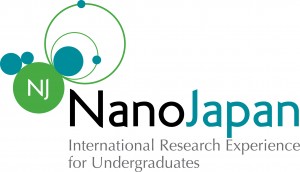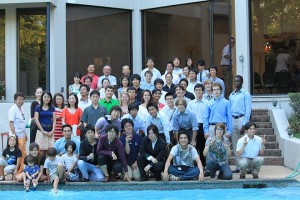The Nakatani RIES Fellowship team has extensive prior experience in the development and management of international education and research experience programs for U.S. and Japanese science and engineering students. The programs outlined below have provided our team with a solid foundation in the needs, challenges, and opportunities of directed international research experience programs for both U.S. and Japanese students.
 NanoJapan: International Research Experience for Undergraduates
NanoJapan: International Research Experience for Undergraduates
The international nature of science and engineering research demands that students have the skill-sets necessary to collaborate internationally. However, limited options exist for science and engineering undergraduates who want to pursue research abroad. The NanoJapan International Research Experience for Undergraduates Program is an innovative response to this need. Developed to foster research and international engagement among young undergraduate students, it is funded by a National Science Foundation Partnerships for International Research and Education (PIRE)grant from 2006 – 2015.
Each summer, NanoJapan sent students to Japan to conduct research internships with world leaders in terahertz (THz) spectroscopy, nanophotonics, and ultrafast optics. The students participate in cutting-edge research projects managed within the framework of the U.S-Japan NSF-PIRE collaboration. One of our focus topics is THz science and technology of nanosystems (or ‘TeraNano’), which investigates the physics and applications of THz dynamics of carriers and phonons in nanostructures and nanomaterials. Ultimately, the program aims to increase the number of U.S. students who choose to pursue graduate study in this field, while cultivating a generation of globally aware engineers and scientists who are prepared for international research collaboration.
Each NanoJapan participant was assigned an English-speaking Japanese graduate student or post-doctoral research who is working on the larger overall PIRE research project within that lab to serve as their day-to-day research mentor. The PIRE Japanese student often works with multiple NanoJapan students over the course of their master’s or Ph.D. program and benefits from the opportunity to mentor young U.S. undergraduates and strengthen their conversational English skills. Japanese professors report that the U.S. students’ enthusiasm and motivation for research positively impacts the lab. As one Japanese professor shared, “[The NanoJapan students] never hesitate to ask questions to our colleagues. Seeing these good attitudes, our Japanese students also get more active, and even change their attitudes for their research in a good way. This is definitely a big benefit for our laboratory.”
From 2006 – 2015, 144 students have participated, representing 49 universities. NanoJapan has been particularly successful with recruiting groups underrepresented in STEM fields; 35.4% of participants are women, and 16.8% represent diverse ethnic groups in STEM fields (not Asian or Caucasian). To date, eleven NanoJapan students have been listed a co-authors in peer-reviewed journal articles including Applied Physics Letters, Carbon, Physical Review B, Nano Letters, Nano Research, Nanoscale Research Letters, and Scientific Reports. Of the 109 NanoJapan alumni who have completed their undergraduate degree, 64.2% are pursuing or have received a graduate degree in a STEM field; representing 38 domestic and 5 international graduate institutions or programs. NanoJapan alumni have also been highly competitive for major national and international fellowships and scholarships and 26.9% of our alumni have participated in further international experiences at both the undergraduate and graduate level.
The NanoJapan: IREU Program design, combining the best aspects of a traditional study abroad experience with intensive nanotechnology research internships, has been nationally recognized as an innovative and effective model for international STEM programs. In 2012, NanoJapan was profiled in a National Academy of Engineering Report on “Infusing Real World Experience into Engineering Education” (see pg. 33) and in 2008 NanoJapan received the IIE Heiskell Award as a ‘Best Practice in Study Abroad’ for expanding opportunities for STEM students.
For more on these awards and related NanoJapan engineering education research and publications to date click here.

Rice University NanoREIS: Research Experiences for International Students Program
Building off of the successful NanoJapan: IREU Program Model, our team at Rice developed a program to host Japanese graduate students for short-term research visits with funding provided by the student’s home university in Japan. The program began in 2008 with 5 students from Hokkaido University coming to Rice for research internships ranging from 1½ to 4 months.
Students are placed into various research labs within Rice University’s George R. Brown School of Engineering and Wiess School of Natural Sciences with host labs and projects assigned to align with the Japanese students’ research backgrounds and thesis or dissertation research. Our PIRE team coordinates the application and placement process, collaborates with the Office of International Students and Scholars for the visa application, and locates off-campus housing options for the incoming Japanese research interns. Dates are flexible and students may propose to come to Rice at any time, though their dates must align with the schedule and research needs of their proposed host professor at Rice University.
This program has proven highly successful. Since 2008, the NSF TeraNano PIRE Center has brought 90 international students to Rice University for research internships of up to 12 months. Participating students include 13 women (10 from Japan), 1 Assistant Professor, 5 Post-Doctoral Researchers, 17 Ph.D. students, 49 Master’s students, 16 undergraduates and 2 university administrators. Students conduct research in a range of Rice University laboratories and centers within the School of Engineering and School of Natural Sciences. To date, three of these students have opted to pursue doctoral studies in the U.S. or Canada as a direct result of their research experience at Rice University, and a number of other students have pursued professional internships or employment in the U.S. as well.

2011 Reverse NanoJapan
When the Great East Japan Earthquake struck on 3/11, our team worked with the NSF, our partners in Japan, and our colleagues at Rice University to design a new, reverse program, in just one-month’s time. The goal of the program was to make Rice’s unique research facilities available to the Japanese students whose research had been suspended while ensuring that the U.S. students would still be involved in an international research collaboration that was the hallmark of the NanoJapan Program.
With supplemental funding from the NSF, we were able to invite 25 Japanese students to come to Rice University and work side-by-side with the 14 American NanoJapan students from late-May to early August (approximately 10 weeks). The response to this revised program was exceptional, with the 25 Japanese undergraduate and graduate students being recruited to participate in just one month’s time. The 39 U.S. and Japanese students were assigned projects in research labs across Rice campus, including in the Departments of Electrical & Computer Engineering, Mechanical Engineering & Materials Science, Chemical & Bimolecular Engineering, Physics & Astronomy, and Chemistry. Students were assigned to labs in teams of U.S. and Japanese students and advised by Rice professors under the direct day-to-day mentorship of a graduate student mentor. At the end of the summer, both the Japanese and U.S. students presented topical research posters on their summer experience at the Rice Quantum Institute’s Summer Research Colloquium.
In addition to research, students also participated in communication skills workshops, career workshops, and a weekly seminar series designed to introduce them to emerging areas of research collaboration and educational exchange between the U.S. and Japan. The U.S. and Japanese students were housed together in the Rice Graduate Apartments and jointly participated in cultural programming and activities hosted by various Rice University offices, the Consulate-General of Japan in Houston, the Japan Association of Greater Houston, and a number of other community organizations.
For more on the 2011 Reverse NanoJapan see the links below.
- View Video of 2011 Reverse NanoJapan
- Read Overview of 2011 Reverse NanoJapan – In English
- Read Overview of 2011 Revesre NanoJapan – In Japanese
- Read Phtonics Spectra article on Reverse NanoJapan – In English
- Read Southern Journal article on Reverse NanoJapan – In Japanese, Pg. 3
- Read Gulfstream: Japanese Business Association of Houston Newsletter article on Reverse NanoJapan – In Japanese
